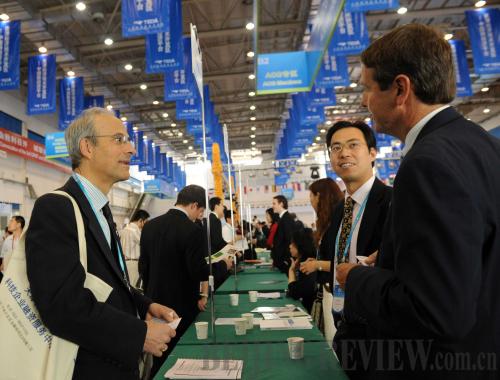|
China is creating a conducive environment to promote mutual benefit and common development between itself and the world beyond, while providing services to transnational companies, Yao said.
Economists are also optimistic concerning China's ability to attract foreign investment in 2010.
Sang Baichuan, a professor at the School of International Trade and Economics of the University of International Business and Economics, thinks since China has adopted a series of measures to expand domestic demand and accelerate economic structural readjustment, rare opportunities for international investors to enter the Chinese market will present themselves. In the meantime, China is actively strengthening its efforts to save energy, reduce wastes emissions and develop a low-carbon economy, which can effectively increase the investment returns rate and attract investments from countries with advantages in the low-carbon economy.
More importantly, as an important economy of sustained growth among a number of economies throughout the globe still recovering, China has a substantial attraction to transnational companies. Most transnational companies are also firmly optimistic about the Chinese market and investment prospects.
"Seven hot industries, such as new energy, clean technologies and biopharmaceutics, will be the first choice of investors," Sang said.
Challenges still exist
Although transnational companies are firmly optimistic about the Chinese market and its investment prospects, and while some transnational companies call the Chinese economy the world's best, China still faces many challenges in attracting foreign investment under current global economic conditions.
According to Sang, influenced by the global financial crisis, capital chains from some transnational companies are tight and even split, weakening their investment capabilities. Therefore many are tightening their investment arrangements and industrial chains, or drawing back investment.
 |
|
ENTHUSIASTIC INVESTORS: Investors from various countries look for investment projects in China at the Third China International Private Equity Forum held in Tianjin on June 10, 2009 (YANG ZONGYOU) |
As the world economy developed, a global industrial labor division was formed: East Asia became the supplier of parts and components, China was the processing and manufacturing base, while European countries and the United States were researchers and developers of core technologies as well as the major markets. The result was a trade surplus by some Asian countries to those in the West. Currently, the trade surplus of China to Europe and the United States is expanding and trade frictions are exacerbated. China's exporting environment has declined, which in turn has caused some export-oriented foreign-invested companies to retreat.
As competition between foreign-invested and domestic-funded companies heats up, some less competitive foreign-invested companies may withdraw from China.
According to Sang, another challenge that cannot be ignored is China has entered an era of climbing costs. Renminbi (yuan) appreciation has led to hikes of capital and real estate prices, and rises in exporting costs. Social and economic development will inevitably increase labor costs. The rise of such costs will weaken the international competitiveness of exported products by foreign-invested companies, which will accelerate the regional transfer of FDI.
"The influence of rising costs will be first reflected in low-end industries, such as labor-intensive industries. China's comparative advantages are gradually weakened and the country is facing challenges from neighboring countries, such as Viet Nam and Malaysia, in attracting foreign investment," Sang said.
Sang suggests that China focus on strategic innovations in utilizing foreign investment. "Facing the changing world economic situation and international FDI environment, China should grasp the opportunities presented by the world economic recovery and utilize its large-scale foreign exchange reserves. Marked improvements can be made in its corporate overseas investment capabilities to be bold in their overseas investments and resolute in transnational mergers and acquisitions," Sang said. "On the other hand, China should actively attract international investment during the process of developing a low-carbon economy, industrial reorganization and expanding service trade."
FDI in 2009
From January to December 2009, China approved 23,435 foreign-invested companies, with contractual investments of $193.51 billion and paid-in capital of $90.03 billion, decreasing 8.4 percent and 2.6 percent, respectively, year on year.
Characteristics of China's attraction of foreign investment:
- Manufacturing industries are still the major force attracting foreign investment, with the decline of paid-in capital narrowing. From January to December, 9,767 foreign-invested manufacturing companies were established; a year-on-year decline of 15.57 percent, while the paid-in capital in the industry was $46.77 billion, dropping 6.26 percent. The number of newly established foreign-invested companies and the paid-in capital accounted for 41.68 percent and 51.95 percent of the country's total, respectively. Since October, paid-in capital decreased continually. Most foreign investment attracted by the manufacturing industry was put into manufacturing telecom equipment, computers, electric machines and equipment, raw chemical materials and chemical products, and transport equipment and general equipment.
- The proportion of service industries has increased. From January to December, 11,461 foreign-invested service companies were established, a year-on-year decrease of 14.85 percent, while the paid-in capital stood at $37.87 billion, a drop of 0.67 percent. The paid-in capital accounted for 42.06 percent instead of 41.3 percent in 2008. Most foreign investment in the service industry was mainly put into the distribution service, transport service, computer application service, production and supply of power, gas and water, and tourism and tourism-related service industries.
During 2009, 569 foreign-invested real estate companies were established, increasing 25.88 percent year on year, while the paid-in capital was $16.8 billion, dropping 9.65 percent, which was 7 percentage points higher than the country's average decrease.
- Foreign investment in the agricultural sector increased rapidly. From January to December, 896 foreign-invested companies were established in the farming, forestry, livestock farming and fishing industries, a year-on-year decline of 2.29 percent, while the paid-in capital reached $1.43 billion, up 19.96 percent compared with the same period in 2008. The number of new foreign-invested companies and the paid-in capital accounted for 3.82 percent and 1.59 percent of the country's total, respectively. Paid-in capital in the farming industry was $751 million, surging 35.5 percent year on year.
(Source: Ministry of Commerce) |
